Evaluation of OMI NO2 Vertical Columns Using MAX-DOAS Observations over Mexico City
Abstract
:1. Introduction
2. Methodology
2.1. The OMI Satellite Instrument
2.2. The MAX-DOAS Network in Mexico City
2.3. MMF Retrieval Code
2.4. Surface Measurements
3. Results
3.1. Comparison with Satellite-Based Measurement
3.2. Comparison with RAMA Measurement
4. Conclusions
Author Contributions
Funding
Acknowledgments
Conflicts of Interest
Abbreviations
| ACAT | Acatlán |
| AK | Averaging Kernel |
| AMF | Air Mass Factor |
| AOD | Absorption Optical Depth |
| CUAT | Cuautitlán |
| DANDELIONS | Dutch Aerosol and Nitrogen Dioxide Experiments for vaLIdation of OMI and SCIAMACHY |
| DOMINO | Dutch OMI NO |
| DOF | Degree of Freedom |
| dSCDs | differential Slant Column Densities |
| INTEX-B | Intercontinental Transport Experiment |
| GMI-CTM | Global Modelling Initiative Chemical Transport Model |
| GOCART | Goddard Chemistry Aerosol Radiation and Transport |
| GOME | Global Ozone Monitoring Experiment |
| KNMI | Koninklijk Nederlands Meteorologisch Instituut |
| LST | Local Standard Time |
| MAX-DOAS | MultiAxes Differential Optical Absorption Spectroscopy |
| MCMA | Mexico City Metropolitan Area |
| MMF | Mexican Maxdoas Fit |
| OMI | Ozone Monitoring Instrument |
| RAMA | Red Automática de Monitoreo Atmosférico |
| RMS | Root Mean Square |
| SEDEMA | Secretaría del Medio Ambiente |
| SP | Standard Products |
| TROPOMI | TROPOspheric Monitoring Instrument |
| UNAM | Universidad Nacional Autonoma de Mexico |
| UV | Ultra Violet |
| VALL | Vallejo |
| VCD | Vertical Column Density |
| VMR | Volume Mixing Ratio |
References
- Crutzen, P.J. The role of NO and NO2 in the chemistry of the troposphere and stratosphere. Ann. Rev. Earth Planet. Sci. 1979, 19, 443–472. [Google Scholar] [CrossRef]
- Domenech, X. Origen y Destino de los Contaminantes Atmosféricos. In Química Atmosférica, origen y efectos de la contaminación; Ed. Miraguano: Madrid, Spain, 1991; pp. 43–62. [Google Scholar]
- Wayne, R.P. The Earth’s troposphere. In Chemistry of Atmospheres, and Introduction to the Chemistry of the Atmospheres of Earth, the Planets, and Their Satellites; Oxford University Press: Oxford, UK, 1985. [Google Scholar]
- United Nations, Department of Economics and Social Affairs, Population Division. The World’s Cities in 2018, Data Booklet; United Nations: New York, NY, USA, 2018. [Google Scholar]
- INEGI. Instituto Nacional de Estadística y Geografía. Presentación de resultados. Censo de Población y Vivienda 2020. 2020. Available online: https://www.inegi.org.mx/contenidos/programas/ccpv/2020/doc/Censo2020_Principales_resultados_EUM.pdf (accessed on 14 January 2021).
- Demographia. Demographia World Urban Areas. 16th Annual Edition 2020.06. St. Louis, US 2020. Available online: http://www.demographia.com/db-worldua.pdf (accessed on 13 January 2021).
- Molina, L.T.; Madronich, S.; Gaffney, J.S.; Apel, E.; de Foy, B.; Fast, J.; Ferrare, R.; Herndon, S.; Jimenez, J.L.; Lamb, B.; et al. An overview of the MILAGRO 2006 Campaign: Mexico City emissions and their transport and transformation. Atmos. Chem. Phys. 2010, 10, 8697–8760. [Google Scholar] [CrossRef] [Green Version]
- Solana, O. SEDATU: Secretaría de Desarrollo Agrario y Territorial y Urbano. Anatomy of Mobility in Mexico; Tinta, R., Ed.; The University of Manchester: Manchester, UK, 2018. [Google Scholar]
- INEGI. Instituto Nacional de Estadística y Geografía. Censo de Población y Vivienda 2020. 2021. Available online: https://www.inegi.org.mx/temas/vehiculos/ (accessed on 13 January 2021).
- TomTom, Traffic Index Ranks Urban Congestion WorldWide. Available online: https://www.tomtom.com/en_gb/traffic-index/mexico-city-traffic (accessed on 1 December 2020).
- Belzowski, B.M.; Ekstrom, A. Stuck in Traffic: Analyzing Real Time Traffic Capabilities of Personal Navigation Devices and Traffic Phone Applications; University of Michigan, Transportation Research Institute: Ann Arbor, MI, USA, 2013. [Google Scholar]
- SEDEMA, Secretaría de Medio Ambiente del Gobierno de la Ciudad de México. Inventario de Emisiones de la CDMX 2016. Dirección General de Gestión de Calidad del Aire, Dirección de Programas de Calidad del Aire e Inventario de Emisiones, Ciudad de México 2018. Available online: http://www.aire.cdmx.gob.mx/descargas/publicaciones/flippingbook/inventario-emisiones-2016/mobile/ (accessed on 12 May 2020).
- Boersma, K.F.; Eskes, H.J.; Dirksen, R.J.; van der A, R.J.; Veefkind, J.P.; Stammes, P.; Huijnen, V.; Kleipool, Q.L.; Sneep, M.; Claas, J.; et al. An improved retrieval of tropospheric NO2 columns from the Ozone Monitoring Instrument. Atmos. Meas. Tech. 2017, 4, 1905–1928. [Google Scholar] [CrossRef] [Green Version]
- Arellano, J.; Kruger, A.; Rivera, C.; Stremme, W.; Friedrich, M.; Bezanilla, A.; Grutter, M. The MAX-DOAS network in Mexico City to measure atmospheric pollutants. AMT 2016, 10, 157–167. [Google Scholar]
- Verhoelst, T.; Compernolle, S.; Pinardi, G.; Lambert, J.-C.; Eskes, H.J.; Eichmann, K.-U.; Fjæraa, A.M.; Granville, J.; Niemeijer, S.; Cede, A.; et al. Ground-based validation of the Copernicus Sentinel-5p TROPOMI NO2 measurements with the NDACC ZSL-DOAS, MAX-DOAS and Pandonia global networks. Atmos. Meas. Tech. 2020, 17, 2189–2215. [Google Scholar]
- Rodgers, C. Intercomparison of remote sounding instrument. J. Geoph. Res. 2003, 108. [Google Scholar] [CrossRef] [Green Version]
- Baylon, J.L.; Stremme, W.; Grutter, M.; Hase, F.; Blumenstock, T. Background CO2 levels and error analysis from ground-based solar absorption IR measurements in central Mexico. Atmos. Meas. Tech. 2017, 10, 2425–2434. [Google Scholar] [CrossRef] [Green Version]
- Krotkov, N.; Lamsal, L.; Celarier, E.; Swartz, W.; Marchenko, S.; Bucsela, E.; Chan, K.; Wening, M.; Zara, M. The version 3 OMI NO2 standard product. Atmos. Meas. Tech. 2017, 10, 3113–3149. [Google Scholar] [CrossRef] [Green Version]
- Hains, J.C.; Boersma, K.F.; Kroon, M.W.; Dirksen, R.J.; Cohen, R.C.; Perring, A.E.; Bucsela, E.; Volten, V.; Swart, D.; Richter, A.; et al. Testing and improving OMI DOMINO tropospheric NO2 using observations from the DANDELIONS and INTEX-B validation campaigns. J. Geophys. Res. 2010, 115. [Google Scholar] [CrossRef]
- Strahan, S.E.; Duncan, B.N.; Hoor, P. Observationally derived transport diagnostics for the lowermost stratosphere and their application to the GMI chemistry and transport model. Atmos. Chem. Phys. 2007, 7, 2435–2445. [Google Scholar] [CrossRef] [Green Version]
- Bucsela, E.J.; Celarier, E.A.; Gleason, J.L.; Krotkov, N.A.; Lamsal, L.N.; Marchenko, S.V.; Swartz, W. OMINO2 README Document. Data Product Version 3.0; Tech. Rep. NASA; Goddard Space Flight Center: Greenbelt, MD, USA, 2016. [Google Scholar]
- Lamsal, L.N.; Krotkov, N.A.; Celarier, E.A.; Swartz, W.H.; Pickering, K.E.; Bucsela, E.J.; Gleason, J.F.; Martin, R.V.; Philip, S.; Irie, H.; et al. Evaluation of OMI operational standard NO2 column retrievals using in situ and surface-based NO2 observations. Atmos. Chem. Phys. 2014, 14, 11587–11609. [Google Scholar] [CrossRef] [Green Version]
- Chin, M.; Diehl, T.; Tan, Q.; Prospero, J.M.; Kahn, R.A.; Remer, L.A.; Yu, H.; Sayer, A.M.; Bian, H.; Geogdzhayev, I.V.; et al. Multi-decadal aerosol variations from 1980 to 2009: A perspective from observations and a global model. Atmos. Chem. Phys. 2014, 14, 3657–3690. [Google Scholar] [CrossRef] [Green Version]
- Boersma, K.F.; Braak, R.; Van der A, R.J. Dutch OMI NO2 (DOMINO) Data Product v2.0, HE5 Data File User Manual; Royal Netherlands Meteorological Institute (KNMI): De Bilt, The Netherlands, 2011. [Google Scholar]
- Huijnen, V.; Williams, J.; Van Weele, M.; Noije, T.; Krol, M.; Dentener, F.; Segers, A.J.; Houweling, S.; Peters, W.; Laat, A.T.J.; et al. The global chemistry transport model TM5: Description and evaluation of the tropospheric chemistry version 3.0. Geosci. Model Dev. Discuss. 2008, 3, 445–473. [Google Scholar] [CrossRef] [Green Version]
- Platt, U.; Stutz, J. Differential Absorption Spectroscopy; Springer: Berlin/Heidelberg, Germany, 2008; pp. 135–174. [Google Scholar]
- Bucsela, E.J.; Celarier, E.A.; Wenig, M.O.; Gleason, J.F.; Veefkind, J.P.; Boersma, K.F.; Brinksma, E.J. Algorithm for NO2 vertical column retrieval from the Ozone Monitoring Instrument. IEEE Trans. Geosci. Remote Sens. 2006, 44, 1245–1258. [Google Scholar] [CrossRef]
- Chan, K.L.; Wang, Z.; Ding, A.; Heue, K.-P.; Shen, Y.; Wang, J.; Zhang, F.; Shi, Y.; Hao, N.; Wenig, M. MAX-DOAS measurements of tropospheric NO2 and HCHO in Nanjing and a comparison to ozone monitoring instrument observations. Atmos. Chem. Phys. 2019, 19, 10051–10071. [Google Scholar] [CrossRef] [Green Version]
- Wang, Y.; Lampel, J.; Xie, P.; Beirle, S.; Li, A.; Wu, D.; Wagner, T. Ground-based MAX-DOAS observations of tropospheric aerosols, NO2, SO2 and HCHO in Wuxi, China, from 2011 to 2014. Atmos. Chem. Phys. 2017, 17, 2189–2215. [Google Scholar] [CrossRef] [Green Version]
- Shaiganfar, R.; Beirle, S.; Petetin, H.; Zhang, Q.; Beekmann, M.; Wagner, T. New concepts for the comparison of tropospheric NO2 column densities derived from car-MAX-DOAS observations, OMI satellite observations and the regional model CHIMERE during two MEGAPOLI campaigns in Paris 2009/10. Atmos. Meas. Tech. 2015, 8, 2827–2852. [Google Scholar] [CrossRef] [Green Version]
- Kanaya, Y.; Irie, H.; Takashima, H.; Iwabuchi, H.; Akimoto, H.; Sudo, K.; Gu, M.; Chong, J.; Kim, Y.J.; Lee, H.; et al. Long-term MAX-DOAS network observations of NO2 in Russia and Asia (MADRAS) during the period 2007–2012: Instrumentation, elucidation of climatology, and comparisons with OMI satellite observations and global model simulations. Atmos. Chem. Phys. 2014, 14, 7909–7927. [Google Scholar] [CrossRef] [Green Version]
- Pinardi, G.; Van Roozendael, M.; Hendrick, F.; Theys, N.; Abuhassan, N.; Bais, A.; Boersma, F.; Cede, A.; Chong, J.; Donner, S.; et al. Validation of tropospheric NO2 column measurements of GOME-2A and OMI using MAX-DOAS and direct sun network observations. Atmos. Meas. Tech. Discuss. 2020, 76. [Google Scholar] [CrossRef] [Green Version]
- Rodgers, C. Error Analysis and Characterisation. In Inverse Methods for Atmospheric Sounding. Theory and Practice; World Scientific Publishing Co.: Oxford, UK, 2000; pp. 43–61. [Google Scholar]
- Salcido, A.; Carreon, S.; Georgiadis, T.; Celada, A.; Castro, T. Lattice wind description and characterization of Mexico City local wind events in the 2001–2006 period. Climate 2015, 3, 542–562. [Google Scholar] [CrossRef] [Green Version]
- Danckert, T.; Fayt, C.; Van Roozendael, M.; De Smedt, I.; Letocart, V.; Merlaud, A.; Pinardi, G. QDOAS Software User Manual; Belgian Institute for Space Aeronomy Uccle: Brussels, Belgium, 2013; p. 117. [Google Scholar]
- Hermans, C.A.C.; Vandaele, M.; Carleer, S.; Fally, R.; Colin, A.; Jenouvrier, B.; Coquart, M.F.M. Absorption cross-sections of atmospheric constituents: NO2, O2, and H2O. Environ. Sci. Pollut. Res. 1999, 6, 151–158. [Google Scholar] [CrossRef] [PubMed] [Green Version]
- Burrows, J.P.; Richter, A.; Dehn, A.; Deters, B.; Himmelmann, S.; Voigt, S.; Orphal, J. Atmospheric remote sensing reference data from GOME-2. temperature dependent absorption cross sections of O3 in the 231–794 nm range. J. Quant. Spectrosc. Radiat. 1999, 61, 509–517. [Google Scholar] [CrossRef]
- Vandaele, A.C.; Hermans, C.; Simon, P.C.; Carleer, M.; Colin, R.; Fally, S.; Merienne, M.F.; Jenouvrier, A.; Coquart, B. Measurements of the NO2 absorption cross-section from 42,000 cm−1 to 10,000 cm−1 (238–1000 nm) at 220 K and 294 KJ. Quant. Spectrosc. Radiat. 1998, 59, 171–184. [Google Scholar] [CrossRef] [Green Version]
- Wilmouth, D.M.; Hanisco, T.F.; Donahue, N.M.; Anderson, J.G. Fourier transform ultraviolet spectroscopy of the A 2Π3/2← X 2Π3/2 transition of BrO. J. Phys. Chem. A 1999, 103, 8935–8945. [Google Scholar] [CrossRef]
- Meller, R.; Moortgat, G.K. Temperature dependence of the absorption cross sections of formaldehyde between 223 K and 323 K in the wavelength range 225–375 nm. J. Geophys. Res. 2000, 105, 7089–7101. [Google Scholar] [CrossRef]
- Kurucz, R.L.; Furenlid, I.; Brault, J.; Testerman, L. Solar flux atlas from 296 to 1300 nm. Nat. Sol. Obs. Atlas 1984, 1, 337–354. [Google Scholar]
- Compernolle, S.; Verhoelst, T.; Pinardi, G.; Granville, J.; Lambert, J.C. S5P MPC VDAF Validation Web Article: Nitrogen Dioxide Column Data. Available online: https://mpc-vdaf.tropomi.eu/ProjectDir/reports//pdf/S5P-MPC-VDAF-WVA-L2_NO2_20180904.pdf (accessed on 12 January 2021).
- Fehr, T. Sentinel-5 Precursor. Scientific Validation Implementation Plan; EOP-SM/2993/TF-tf; European Space Agency: Paris, France, 2016. [Google Scholar] [CrossRef]
- Friedrich, M.M.; Rivera, C.; Stremme, W.; Ojeda, Z.; Arellano, J.; Bezanilla, A.; García-Reynoso, J.A.; Grutter, M. NO2 vertical profiles and column densities from MAX-DOAS measurements in Mexico City. Atmos. Meas. Tech. 2019, 12, 2545–2565. [Google Scholar] [CrossRef] [Green Version]
- Clémer, K.; Van Roozendael, M.; Fayt, C.; Hendrick, F.; Hermans, C.; Pinardi, G.; Spurr, R.; Wang, P.; De Mazière, M. Multiple wavelength retrieval of tropospheric aerosol optical properties from MAXDOAS measurements in Beijing. Atmos. Meas. Tech. 2010, 3, 863–878. [Google Scholar] [CrossRef] [Green Version]
- Frieß, U.; Beirle, S.; Alvarado Bonilla, L.; Bösch, T.; Friedrich, M.M.; Hendrick, F.; Piters, A.; Richter, A.; van Roozendael, M.; Rozanov, V.V.; et al. Intercomparison of MAX-DOAS vertical profile retrieval algorithms: Studies using synthetic data. Atmos. Meas. Tech. 2019, 12, 2155–2181. [Google Scholar] [CrossRef] [Green Version]
- Spurr, R.J.D.; Kurosu, T.P.; Chance, K.V. A linearized discrete ordinate radiative transfer model for atmospheric remote-sensing retrieval. J. Quant. Spectrosc. Radiat. 2001, 68, 689–735. [Google Scholar] [CrossRef]
- Spurr, R.J.D. A linearized pseudo-spherical vector discrete ordinate radiative transfer code for forward model and retrieval studies in multilayer multiple scattering media. J. Quant. Spectrosc. Radiat. 2006, 102, 316–342. [Google Scholar] [CrossRef]
- Spurr, R.J.D. User’s Guide VLIDORT Version 2.6; RT Solutions, Inc.: Cambridge, MA, USA, 2013. [Google Scholar]
- Rivera, C.; Guarín, C.; Stremme, W.; Friedrich, M.; Bezanilla, A.; Rivera, D.; Mendoza, C.; Grutter, M.; Blumenstock, T.; Hase, F. Formaldehyde total column densities over Mexico City: Comparison between MAX-DOAS and solar absorption FTIR measurements. Atmos. Meas. Tech. Discuss. 2020, 208, 1–27. [Google Scholar]
- García-Franco, J.L.; Stremme, W.; Bezanilla, A.; Ruiz-Angulo, A.; Grutter, M. Variability of the Mixed-Layer Height Over Mexico City. Bound.-Layer Meteorol. 2018, 167, 493–507. [Google Scholar] [CrossRef]
- Lamsal, L.; Martin, R.; Donkelaar, A.; Celarier, E.; Bucsela, E.; Boersma, K.; Dirksen, R.; Luo, C.; Wang, Y. Indirect validation of tropospheric nitrogen dioxide retrieved from the OMI satellite instrument: Insight into the seasonal variation of nitrogen oxides at northern midlatitudes. J. Geophys. Res. 2010, 115. [Google Scholar] [CrossRef]
- Rivera, C.; Stremme, W.; Grutter, M. Nitrogen dioxide DOAS measurements from ground and space: Comparison of zenith scattered sunlight ground-based measurements and OMI data in Central Mexico. Atmosfera 2013, 26, 401–414. [Google Scholar] [CrossRef] [Green Version]
- Melamed, M.L.; Basaldud, R.; Steinbrecher, R.; Emeis, S.; Ruíz-Suárez, L.G.; Grutter, M. Detection of pollution transport events southeast of Mexico City using ground-based visible spectroscopy measurements of nitrogen dioxide. Atmos. Chem. Phys. 2009, 9, 4827–4840. [Google Scholar] [CrossRef] [Green Version]

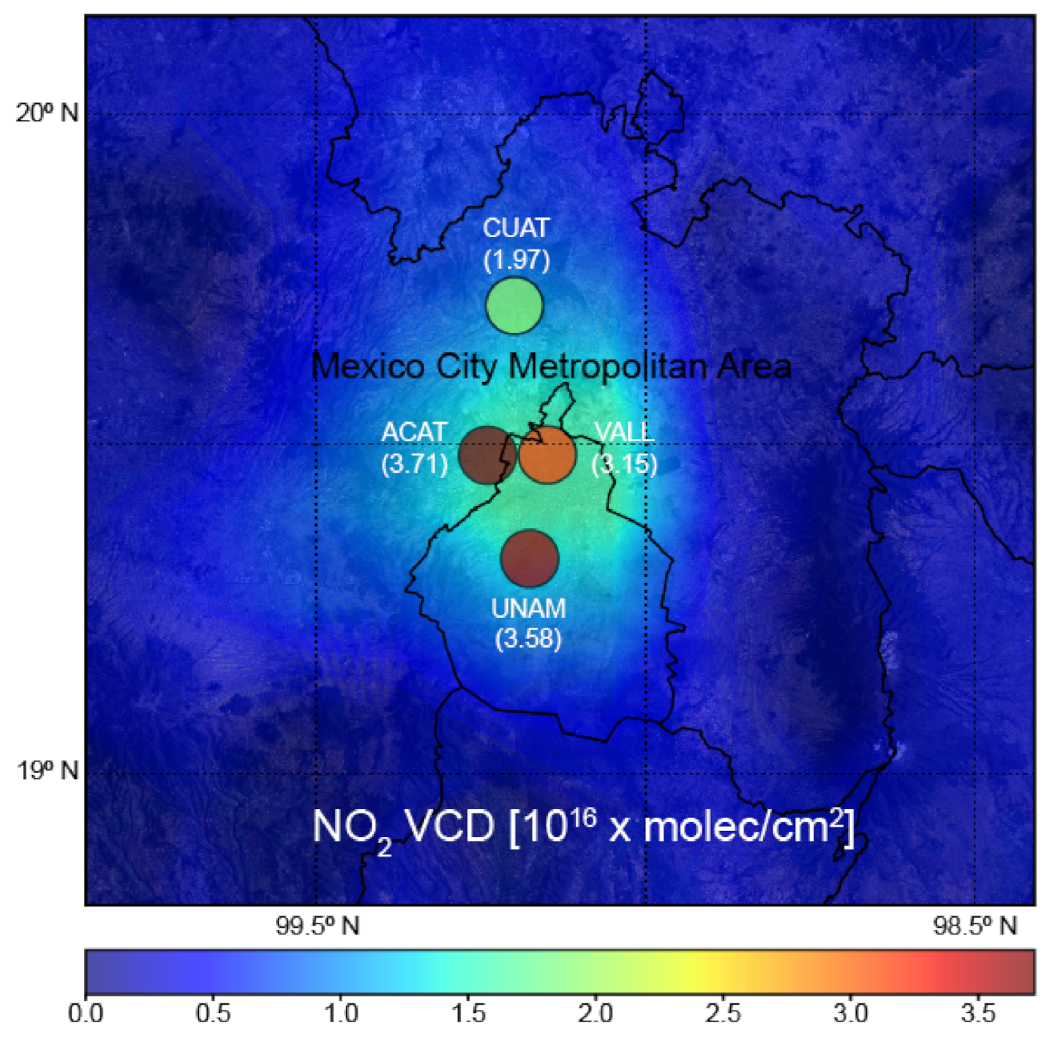
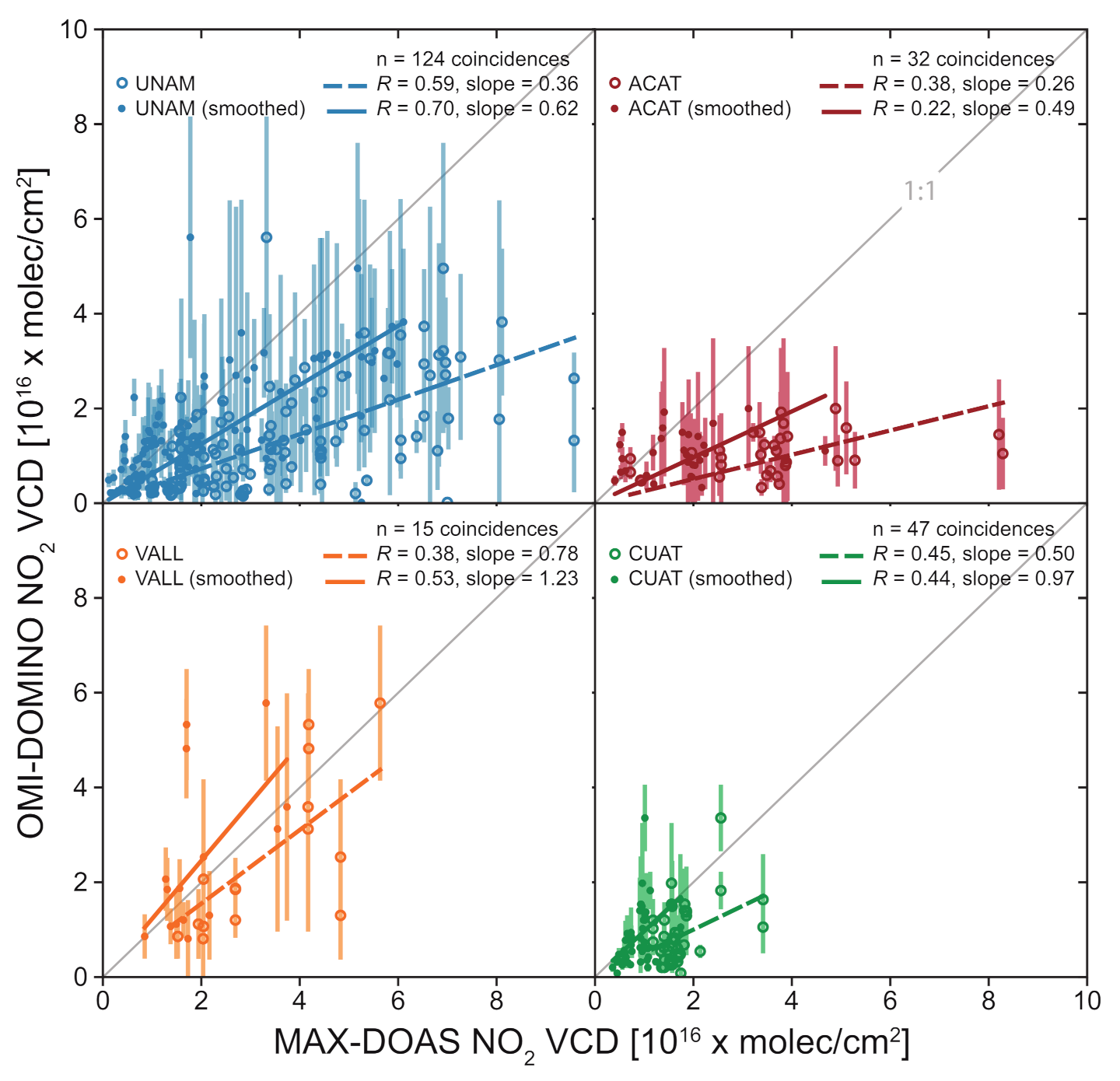

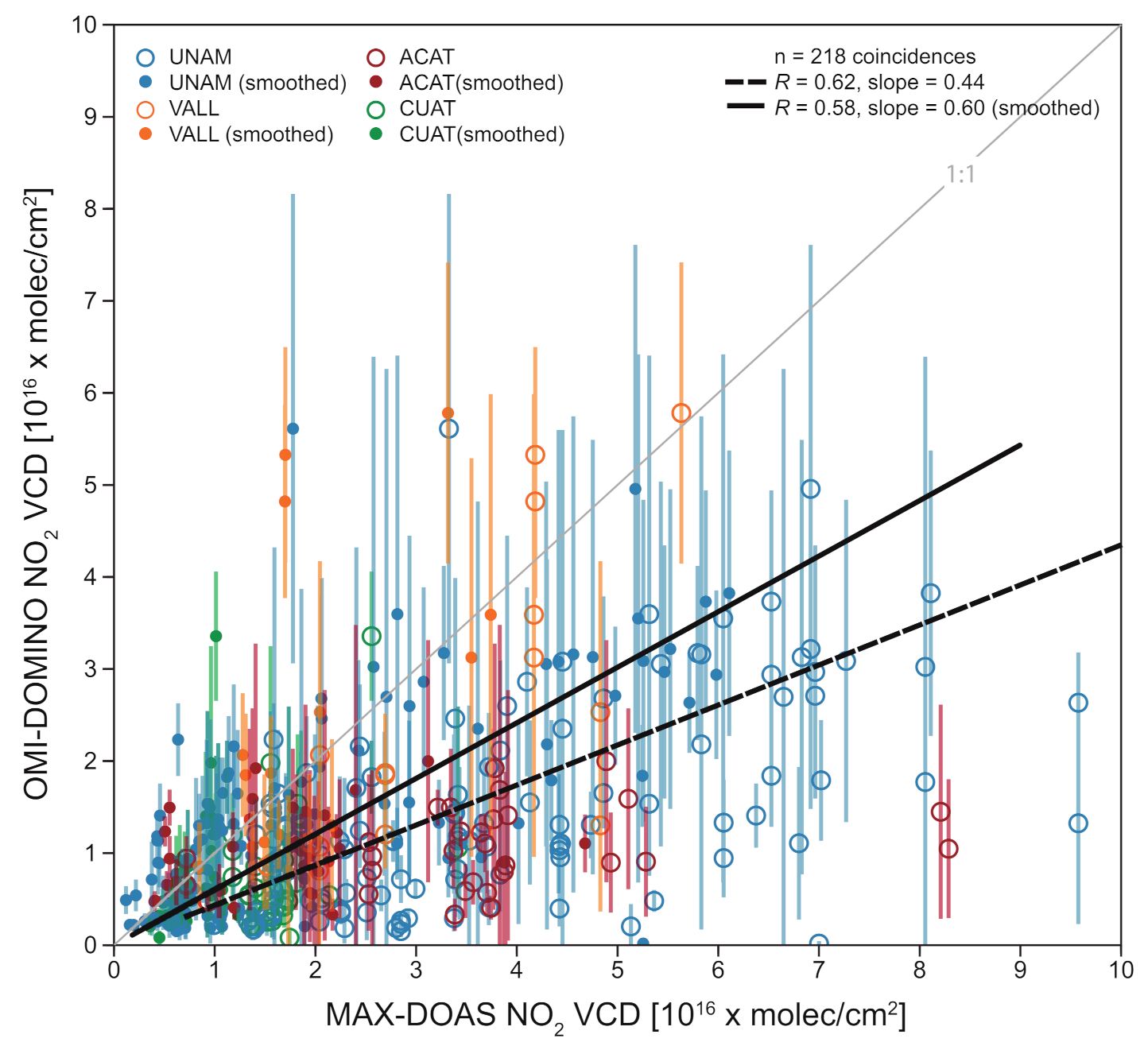
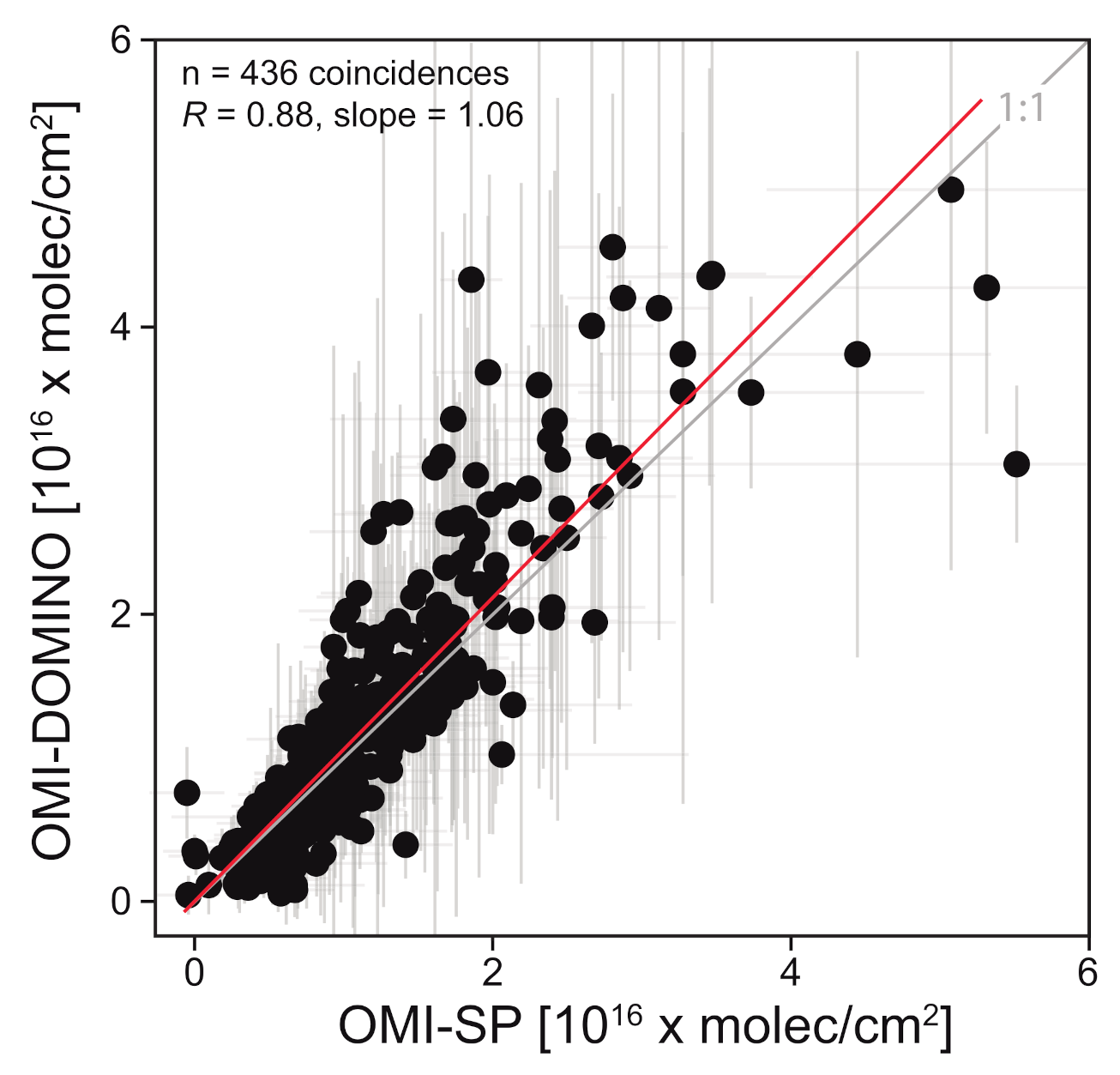
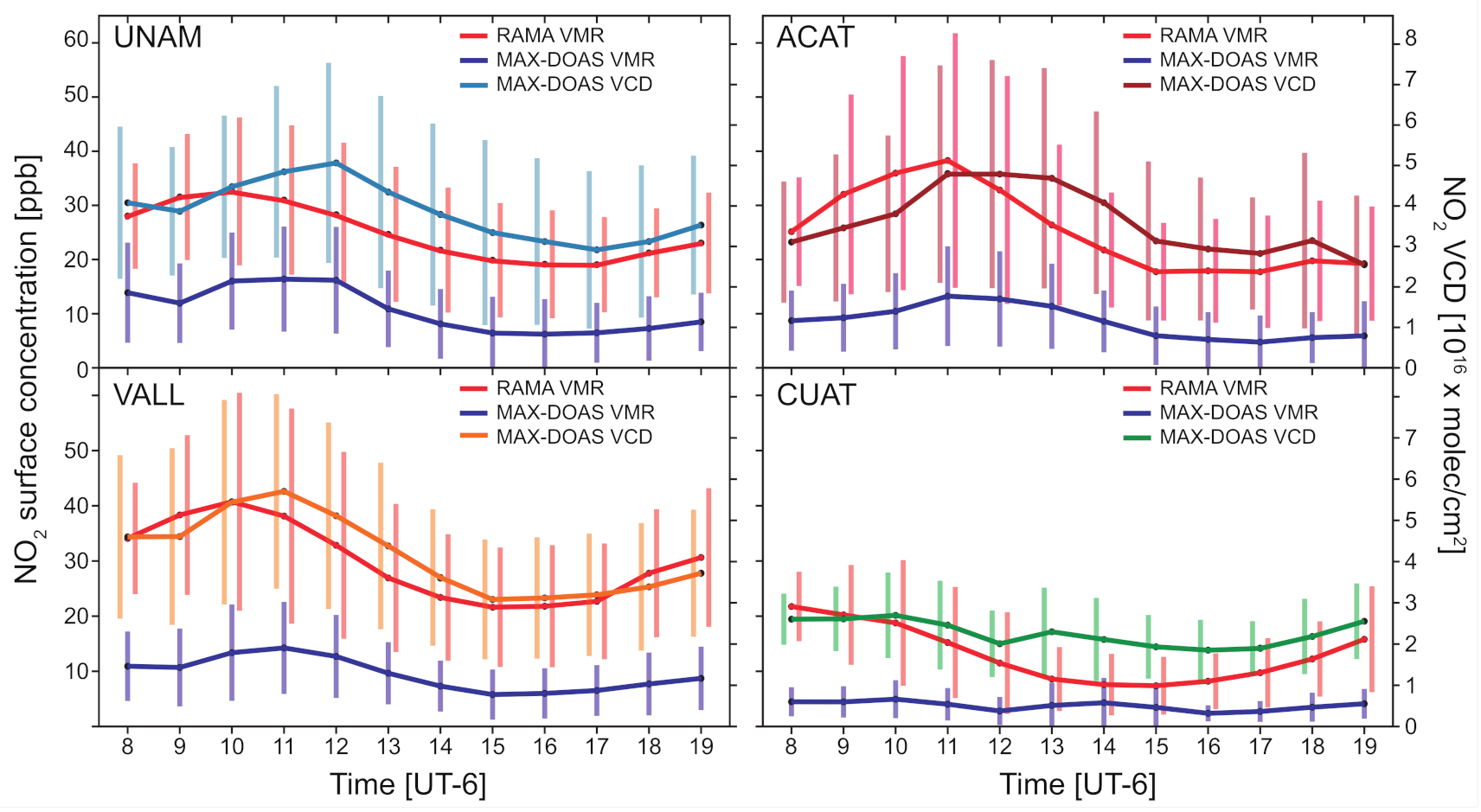
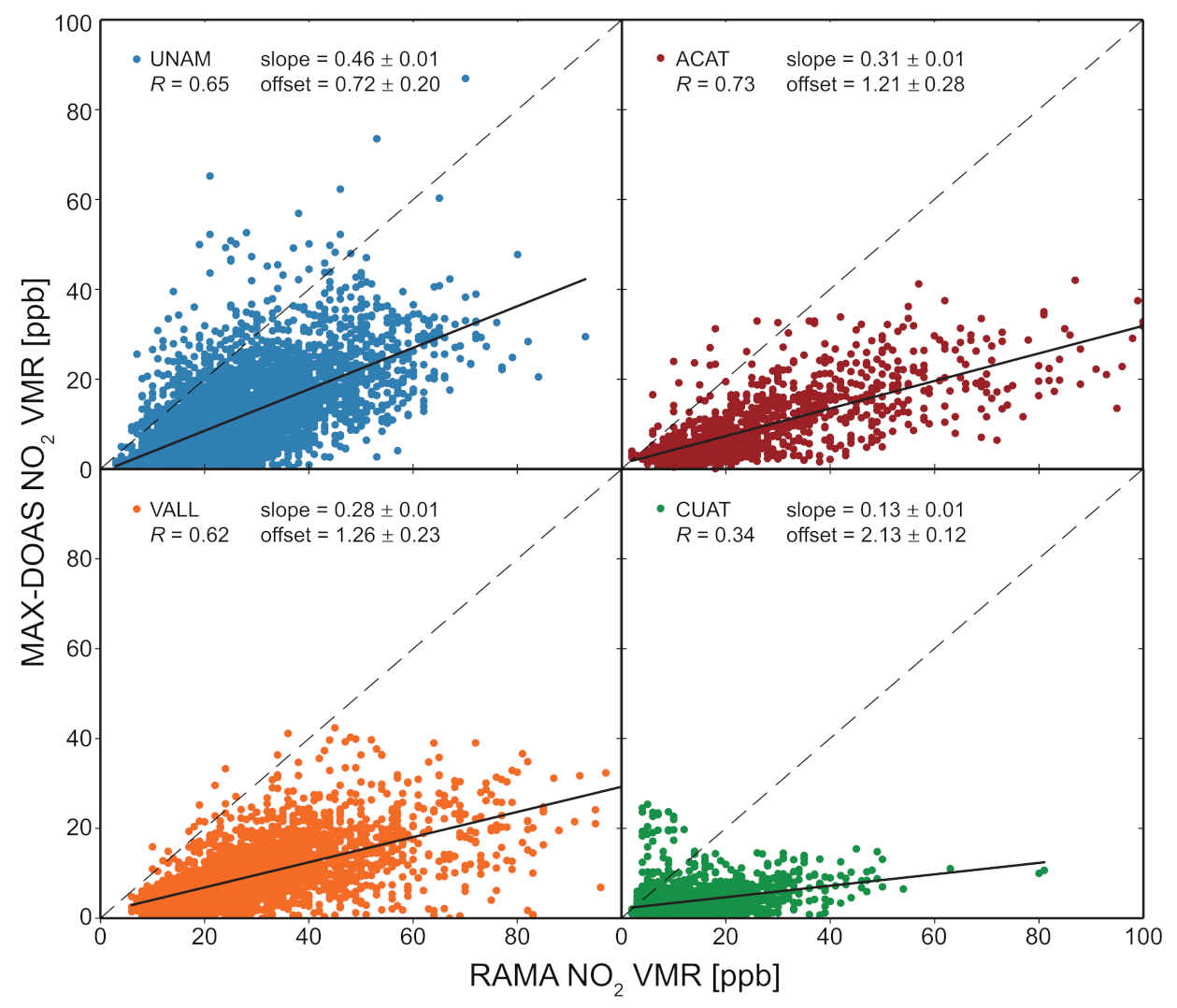
| UNAM | VALL | ACAT | CUAT | |||||
|---|---|---|---|---|---|---|---|---|
| Around Satellite overpass time (13–15 LST) | ||||||||
| molec/cm | % | molec/cm | % | molec/cm | % | molec/cm | % | |
| Noise | 1.1 | 1.2 | 1.15 | 2.8 | ||||
| Forward | 10.4 | 13.2 | 13.3 | 17.7 | ||||
| Smooth | 6.5 | 7.6 | 6.8 | 19.5 | ||||
| Parameters | 9.4 | 6.1 | 5.4 | 21.2 | ||||
| Total error | 15.5 | 16.5 | 16.0 | 34.0 | ||||
| All Day (7–19 LST) | ||||||||
| molec/cm | % | molec/cm | % | molec/cm | % | molec/cm | % | |
| Noise | 2.4 | 1.9 | 1.9 | 3.0 | ||||
| Forward | 12.3 | 15.5 | 19.4 | 26.3 | ||||
| Smooth | 12.6 | 13.0 | 12.2 | 19.3 | ||||
| Parameters | 9.4 | 6.1 | 5.4 | 51.9 | ||||
| Total error | 20.1 | 21.2 | 23.6 | 61.4 | ||||
Publisher’s Note: MDPI stays neutral with regard to jurisdictional claims in published maps and institutional affiliations. |
© 2021 by the authors. Licensee MDPI, Basel, Switzerland. This article is an open access article distributed under the terms and conditions of the Creative Commons Attribution (CC BY) license (http://creativecommons.org/licenses/by/4.0/).
Share and Cite
Ojeda Lerma, Z.; Rivera Cardenas, C.; Friedrich, M.M.; Stremme, W.; Bezanilla, A.; Arellano, E.J.; Grutter, M. Evaluation of OMI NO2 Vertical Columns Using MAX-DOAS Observations over Mexico City. Remote Sens. 2021, 13, 761. https://doi.org/10.3390/rs13040761
Ojeda Lerma Z, Rivera Cardenas C, Friedrich MM, Stremme W, Bezanilla A, Arellano EJ, Grutter M. Evaluation of OMI NO2 Vertical Columns Using MAX-DOAS Observations over Mexico City. Remote Sensing. 2021; 13(4):761. https://doi.org/10.3390/rs13040761
Chicago/Turabian StyleOjeda Lerma, Zuleica, Claudia Rivera Cardenas, Martina M. Friedrich, Wolfgang Stremme, Alejandro Bezanilla, Edgar J. Arellano, and Michel Grutter. 2021. "Evaluation of OMI NO2 Vertical Columns Using MAX-DOAS Observations over Mexico City" Remote Sensing 13, no. 4: 761. https://doi.org/10.3390/rs13040761
APA StyleOjeda Lerma, Z., Rivera Cardenas, C., Friedrich, M. M., Stremme, W., Bezanilla, A., Arellano, E. J., & Grutter, M. (2021). Evaluation of OMI NO2 Vertical Columns Using MAX-DOAS Observations over Mexico City. Remote Sensing, 13(4), 761. https://doi.org/10.3390/rs13040761







